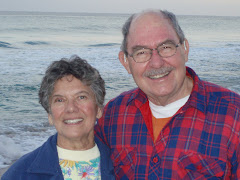Below are a couple of pictures from Haines. First, please see a picture of me in front of the Hammer Museum, which I described in an earlier posting. We thought the huge hammer was pretty interesting!
There are many eagles in Haines, and even more in the winter, so we understand. I believe they winter here because the river flowing into Haines does not freeze, and is a source of fish for the birds. We saw eagles sitting on posts in the harbor, and in trees on the main street.
Haines and Skagway are about the same size, but are very different. An occasional cruise ship stops in Haines -- I think two ships, for a one-day stay, each, when we were there. Skaqway is visited by many cruise ships. There were four in port the day we arrived. Consequently there are surges of tourist in the streets, and many shops opened which cater to tourists. One day the street is crowded, the next day relatively deserted, depending how many cruise ships are in port.
Skagway and the nearby former town of, Dyea (pronounce Dii ee, rhymes with "pie see"), were the beginning of the two major trails over the coastal mountains to Whitehorse, and then by river to the Klondike.
The Chilkoot Trail started in Dyea. In 1898, Dyea had a population of 8,000. In 1903, when the gold rush was over, it had a population of 3. Now the town is gone, and is nothing but cellar holes, rotted timbers and pilings and forest. Nevertheless, the former town is now a National Park, and I suppose is an extension of the Chilkoot Trail National Park. The National Park has an interpretive ranger, who gave us a delightful tour of the old town site. We certainly got a impression of what life must have been like there in the late 1890's.
The Chilkoot Trail, is the trail frequently shown in movies and documentaries. The entire trail is a National Park. The trail was 33 miles, and was the shortest route to Whitehorse and to the Kondike. We started a small hike on the trail (See picture of "Sourdough Dan"). We found he trail started with steep climbing. We wondered how the stampeeders did it, and learned that they usually went in the winter, and traveling was actually easier in the winter. The trail follow a river, and when frozen, the men could pull sleds full of goods on the river ice. The "Scales", the area which has been so frequently photographed of a single file of men carrying their goods on the final trek over Chilkoot Pass, while difficult, is said to have been easier in the winter, because the trail goes over huge boulders, which are covered with snow in the winter. There steps are cut into the ice, upon which the would-be miners trekked up single file.
The miners were required by the Canadian Mounties to carry about a ton of goods, so they could survive a year. They were checked when they crossed the border, at the top of the pass -- the border between Alaska and Canada. This required many trips, caching the supplies, and returning for more. Later, tramways were built, offering the option of ferrying the goods. However, the Chilkoot Trail was the poor man's trail, so many stampeeders carries all their supplies over on their backs, repeating their trips many times.
On our return to Skagway, we saw a bear at the side of the road eating berries. There is a picture here of the bear standing on his back legs. The bears seem to eat an immense amount of leaves, when they eat the berries. We now are getting adept to identifying bear scat on the trail,and can even tell if it is fresh (Caution, Bear Ahead!) or four hours old (Wot, me worry?)
Today we will take the road up to look at White Pass. White Pass is the other Gold Rush route to Whitehorse. White Pass is lower than Chilkoot Pass, the trail longer than the Chilkoot Trail. The trail could be transversed with horses. However, the trail was so steep and narrow, and became so muddy, and the stampeeders in such a hurry, that, it became known as the "Dead Horse Trail". There are many photographs of dead hoses lying along the trail.
Later a railroad was built up over White Pass. While the railroad was completed after the gold rush has subsided, it became for many years the chief route for supplying the Klondike and Dawson City, with good being transported from
Seattle to Skagway by ship, then Skagway to Whitehorse by rail, and the Whitehorse to Dawson city by steamboat on the Yukon River.





No comments:
Post a Comment